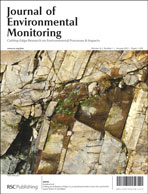Soil is the major environmental reservoir of organic compounds and soil–air exchange is a key process in governing the environmental fate of these compounds on a regional and global scale. Samples of air and soil were collected to study the levels of PAHs in the air and soil of the Agra region. Concentrations of PAH measured at four locations in the city of Agra, covers industrial, residential, roadside and agricultural areas. Samples were extracted with hexane by ultrasonic agitation. Extracts were then fractioned on a silica-gel column and the aromatic fraction was analysed by GC-MS. The mean concentration of the total PAH (T-PAH) in the air of Agra was 24.95, 17.95 and 14.25 ng m−3, during winter, monsoon and summer respectively. The average concentration of T-PAH in the soil of Agra was 12.50, 8.25 and 6.44 μg g−1 in winter, monsoon and summer seasons respectively. The aim of this study was to investigate the rate of approach to equilibrium partitioning of PAHs between air and soil compartments and to determine the direction of net flux of the studied PAH between air and soil. Calculated soil–air fugacity quotients indicate that the soil may now be a source of some lighter weight PAHs to the atmosphere, whereas it appears to be still acting as a long-term sink for the heavier weight PAHs to some extent in this region.

You have access to this article
 Please wait while we load your content...
Something went wrong. Try again?
Please wait while we load your content...
Something went wrong. Try again?


 Please wait while we load your content...
Please wait while we load your content...